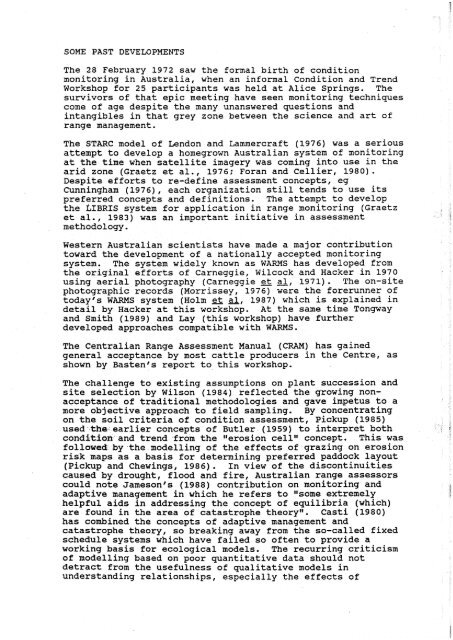soil-conservation-people-religion-and-land.pdf - South West NRM
soil-conservation-people-religion-and-land.pdf - South West NRM
soil-conservation-people-religion-and-land.pdf - South West NRM
You also want an ePaper? Increase the reach of your titles
YUMPU automatically turns print PDFs into web optimized ePapers that Google loves.
SOME PAST DEVELOPMENTS<br />
The 28 February 1972 saw the formal birth of condition<br />
monitoring in Australia, when an informal condition <strong>and</strong> Trend<br />
Workshop for 25 participants was held at Alice Springs. The<br />
survivors of that epic meeting have seen monitoring techniques<br />
come of age despite the many unanswered questions <strong>and</strong><br />
intangibles in that grey zone between the science <strong>and</strong> art of<br />
range management.<br />
The STARC model of Lendon <strong>and</strong> Lammercraft (1976) was a serious<br />
attempt to develop a homegrown Australian system of monitoring<br />
at the time when satellite imagery was coming into use in the<br />
arid zone (Graetz et al., 1976; Foran <strong>and</strong> ~ellier, 1980).<br />
Despite efforts to re-define assessment concepts, eg<br />
cunningham (1976), each organization still tends to use its<br />
preferred concepts <strong>and</strong> definitions. The attempt to develop<br />
the LIBRIS system for application in range monitoring (Graetz<br />
et al., 1983) was an important initiative in assessment<br />
methodology.<br />
<strong>West</strong>ern Australian scientists have made a major contribution<br />
toward the development of a nationally accepted monitoring<br />
system. The system widely known as WARMS has developed from<br />
the original efforts of Carneggie, Wilcock <strong>and</strong> Hacker in 1970<br />
using aerial photography (~arneggie et al, 1971). The on-site<br />
photographic records (Morrissey, 1976) were the forerunner of<br />
today's WARMS system (Holm et al, 1987) which is explained in<br />
detail by Hacker at this workshop. At the same time Tongway<br />
<strong>and</strong> Smith (1989) <strong>and</strong> Lay (this workshop) have further<br />
developed approaches compatible with WARMS.<br />
The Centralian Range Assessment Manual (CRAM) has gained<br />
general acceptance by most cattle producers in the Centre, as<br />
shown by Basten's report to this workshop.<br />
The challenge to existing assumptions on plant succession <strong>and</strong><br />
site selection by Wilson (1984) reflected the growing nonacceptance<br />
of traditional methodologies <strong>and</strong> gave impetus to a<br />
more objective approach to field sampling. By concentrating<br />
on the <strong>soil</strong> criteria of condition assessment, pickup (1985)<br />
used-the earlier concepts of Butler (1959) to interpret both<br />
condition <strong>and</strong> trend from the Iterosion cellv1 concept. This was<br />
followed by the modelling of the effects of grazing on erosion<br />
risk maps as a basis for determining preferred paddock layout<br />
(Pickup <strong>and</strong> Chewings, 1986). In view of the discontinuities<br />
caused by drought, flood <strong>and</strong> fire, ~ustralian range assessors<br />
could note Jameson's (1988) contribution on monitoring <strong>and</strong><br />
adaptive management in which he refers to llsome extremely<br />
helpful aids in addressing the concept of equilibria (which)<br />
are found in the area of catastrophe theoryq1. Casti (1980)<br />
has combined the concepts of adaptive management <strong>and</strong><br />
catastrophe theory, so breaking away from the so-called fixed<br />
schedule systems which have failed so often to provide a<br />
working basis for ecological models. The recurring criticism<br />
of modelling based on poor quantitative data should not<br />
detract from the usefulness of qualitative models in<br />
underst<strong>and</strong>ing relationships, especially the effects of
















